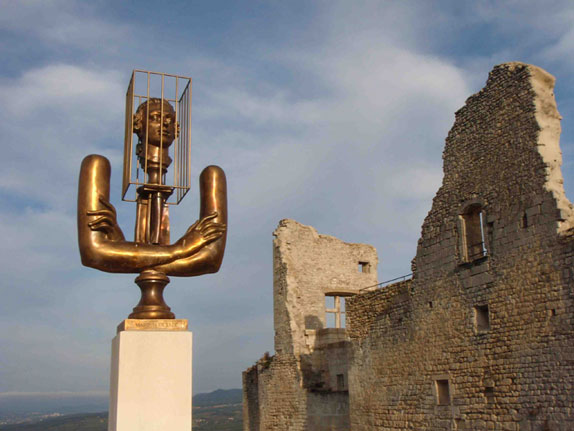
Excerpt From Chapter Three
INFERNAL PROVENCE
Marquis de Sade is Dead! Long Live Pierre Cardin!

France has always been a Coney Island for literature lovers: the land is lousy with shrines like Victor Hugo's apartment in Paris, George Sand's mansion in Nohant, or Balzac's cottage in Passy, where even the author's old coffee-pot is revered like a piece of the True Cross. But a more select breed of bibliophile has long made the pilgrimage to a remote southern village called Lacoste, where the château of one Donatien Alphonse François, Marquis de Sade, looms in decaying grandeur. Born in 1740, Sade remains one of France's more outrageous cultural heroes — an aristocratic libertine who has gone down in history for his maniacal lifestyle and bizarre pornographic novels, including Justine, Juliette and 120 Days of Sodom, each one overflowing with sexual fantasies of such nightmarish cruelty that they gave birth to the term Sadism. For generations, interest in Sade's crumbling refuge in Provence was limited to the cognoscenti. Then, one day in 2001, word leaked out that the Château Sade had an illustrious new owner, the celebrity fashion designer, Pierre Cardin. Ever since, the king of leisure suits has stirred things up in sleepy Lacoste, introducing up-market boutiques, cafes, galleries and hotels, even an annual arts festival, until the villagers are once again revolting.
As for me, I didn't care how famous the new lord of the manor was. This devoted literary tourist just wanted to get inside that castle.
Few writers' homes are so intimately connected to their distinctive creative process. Constructed in the Middle Ages as a fortress against Saracen marauders, the ancestral château had captivated Sade ever since, as a boy, he first saw it crouching above the village like a wolf in ambush. His father gave it to him as a wedding present in 1763, when Sade was a charismatic and promising 24-year-old, and it soon became his most beloved residence, where he lived for energetic interludes over the next fifteen years — his feral prime. Essentially, the château became the mise-en-scène for some of Sade's more controversial real-life escapades, including a light-hearted romp dubbed "The Little Girls Episode" by biographers. This edifying incident occurred in late 1774, when the Marquis, then aged 34, came to winter in Provence with his wife and a string of fresh-faced household servants he'd hired in Lyon. The newcomers — five unsuspecting virgin girls and a handsome teen male "secretary" — were intended to supplement his more experienced castle staff, such as the luscious housekeeper Gothon, whom Sade had hired because she sported "the sweetest ass ever to leave Switzerland," and a studly valet, Latour, by whom Sade liked to be sodomized while prostitutes watched and cavorted.
As far as historians can discern, over the next six weeks Sade dedicated himself to corrupting the captive minors. Holding them hostage in the château's dungeon, he forced them to act out scenes from pornographic novels and his own intricately stage-managed sexual rituals. (Obsessively controlling, he liked to choreograph every detail. As a character complains in one of his fictions, "Let's please put some order into these orgies!") Modern French wives are legendarily indulgent of their husband's peccadilloes, but Sade's wife Pélagie took conjugal freedom to new heights by overseeing this marathon debauch, keeping the five girls compliant, then hushing up the ensuing scandal. When the police came knocking, she helped bribe the outraged parents and spirit the girls, decidedly damaged goods, away to convents.
Over time, the château also took pride of place in Sade's literary imagination. As the biographer Francine du Plessix Gray points out in her classic At Home With the Marquis de Sade, its position hovering above Lacoste fed his outdated fantasies of feudal inviolability, where he could act out his rabid carnal desires with no fear of reprisal. Even later, when Sade was in prison, the château remained a font of inspiration for his grisly literary output — a Walden Pond for the polymorphously perverse.
Speculation has long been rife as to what remained inside the château, particularly the dungeon. Although the edifice was looted during the Revolution and pillaged for its masonry, connoisseurs of erotic literature began arriving in the 19th century to soak up its aura. In 1871, the French art historian P. L. Jacob was told by villagers that the walls of the dungeon were once painted with naked figures dancing in "a type of witch's Sabbath" around supine women, a vision Jacob breathlessly compared to an absinthe hallucination. Later, the bestselling author of salacious history Dr. Augustin Cabanès was informed that revolutionaries had discovered in the dungeon "instruments of torture that served at the Marquis' debauches." ("Or is it just idle gossip?" he mused). Farmers spoke of secret tunnels all through the countryside, used by the Marquis to evade police raids.
By the 20th century, the château had become a louche must-see for the avant-garde traveler to Provence. Surrealists like André Breton, who inflamed the modern fascination with Sade's work, explored it; Man Ray sketched it; Cartier-Bresson and Brassaï photographed it; Lawrence Durrell wrote the racy parts of the Alexandria Quartet in one of Lacoste's cafes. In the 1960s, at the same time as censorship restrictions were finally lifted on Sade's works, artists began moving into Lacoste's cheap stone houses, creating a modest bohemian community. A local schoolteacher, André Bouër, purchased the abandoned castle and made the first basic repairs to it in decades. He held energetic parties there every summer; locals would wake up to see comely filles de joie from Marseilles, their lipstick smeared, teetering down the laneways in high heels.
But it is the château's new owner, Pierre Cardin, who has caused more tumult in Lacoste than anyone since the Marquis himself. The billionaire haute couturier was evidently tickled by the literary connection when he bought the 70 acre estate. He erected a shiny bronze statue of Sade next to the castle, pumped a million Euros into improving the structure, and started a summer theater festival that lured crowds from Paris and the Riviera. (Cardin's website states that the event is a homage to Sade, who loved the stage and put on plays in the château himself). But it soon became obvious that Cardin had grand plans for the village as well. He began buying up Lacoste's historic structures then converting them into galleries and stores. It seemed as if Cardin wanted to take over the whole village, turning it into a "St Tropez of culture." The reaction to this real estate grab amongst most of the original villagers was violent — much more so than if he had been hosting mad orgies in the château. Ever since, Lacoste has been torn apart by a mini-civil war with a viciousness that only French provincials can manage.
* * *
I had no difficulty selling Lacoste to Les, who was so dewy-eyed about her first trip to Provence that she didn't care which village we went to. The boys liked the sound of the menacing castle, thinking they were going to Gondor perhaps. I was relieved to learn that, despite all the renovations, the basic structure of the Château Sade was intact, including the dungeon. But getting an invitation into the private lair of any celebrity can be a tricky business - and the volatile politics of this weird little village made the task of even meeting Monsieur Cardin difficult. But I wasn't heading into the hornet's nest unprepared. I had a connection that would melt any Sade fan's heart . . .
Find out how Tony Perrottet meets Pierre Cardin and talks his way into the Marquis de Sade's dungeon in chapter three of The Sinner's Grand Tour . . .




